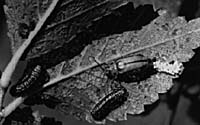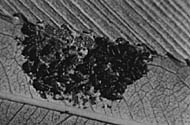 FS-06342
FS-063421994
![]()
 FS-06342
FS-06342
1994
![]()
|
Elm Leaf Beetle Imported Willow Leaf Beetle Cottonwood Leaf Beetle Leaf Beetle Damage Control |
![]()
Leaf beetles are a common group of pests that attack a variety of landscape trees and shrubs in Minnesota. Although there are several species of leaf beetles that occur in Minnesota, the elm leaf beetle, imported willow leaf beetle, and cottonwood leaf beetle are most commonly encountered. These beetle species are similar in appearance as larvae and in the defoliation damage they cause to their respective hosts. When feeding on healthy, mature trees, these beetles are nuisance pests causing only aesthetic plant damage. However, in cases of poor tree health, the added stress caused by beetle feeding can further reduce tree vitality and in rare cases cause death. There are some differences in the life history and habits of each beetle and these are discussed below.
Identification: Adults are 1/4" to 3/8" long, oval, yellow to olive-green, with longitudinal dark stripes running the length of the wing covers. There are three black spots behind the head. Larvae are worm-like, up to 1/2" long when mature, and dull yellow with black stripes. Eggs are yellow-orange, pointed and laid in clusters. Eggs turn purple-black just before larvae are ready to emerge.
 |
Hosts: Elms, including Siberian, American, slippery and other varieties.
Life History: Beetles overwinter as adults in protected locations such as inside homes or underneath loose tree bark. As elm buds begin to expand in spring (about mid-May), beetles move from overwintering sites to begin feeding and egg laying on leaf undersides. Upon emerging from eggs (about 1 week after they are laid), young larvae begin feeding on leaf undersides between the veins, leaving the upper leaf surface intact. This type of feeding gives the leaves a transparent appearance and is often termed "window feeding." As larvae mature, defoliation increases as feeding takes place on both upper and lower leaf surfaces. By eating all foliage except for the leaf veins the larvae "skeletonize" the leaves. Heavy larval feeding can give the tree an overall brown appearance and also cause premature leaf drop. In contrast, adult feeding leaves only small holes through the entire leaf and is usually of minor importance compared with larval feeding. Elm leaf beetle does not transmit Dutch elm disease.
In approximately 2–3 weeks (mid-June), larvae have matured and are finished feeding. They then migrate from feeding sites down the trunk to pupate in the soil at the tree base. Adults emerge 1–2 weeks later and a second generation is usually produced. The adults created from this second generation seek overwintering shelter starting in late August to early September.
Identification: Adults are between 1/8" and 1/4" long, oval, and shiny black to greenish blue. Larvae are black and about 1/4" long at maturity. Eggs are shiny, pale yellow, and laid in irregular groups.
 |
Hosts: Several varieties of willow and poplar, with weeping willow being especially susceptible.
Life History: Beetles overwinter as adults in protected locations near the tree trunk. They emerge in the spring as host buds break (early-mid May), begin producing feeding damage (holes and notches in leaves) and start egg laying activity. Eggs hatch a few days after they are laid and young larvae feed gregariously on leaf undersides, skeletonizing the leaf surface. Larvae feed on upper and lower leaf surfaces as they mature and transform into pupae on leaves about 3–4 weeks after egg hatch. Several generations may be produced in a single season.
Identification: Adults are about 5/16" long, with a black head and thorax; the thorax having yellow margins. The wing covers are usually yellowish with several black stripes. Larvae are black when young, and are black with 2 white spots on each side of the body and about 1/2" long when mature. Eggs are lemon-yellow and laid in clusters.
 |
Hosts: Willow, cottonwood and other poplars.
Life History: Beetles overwinter as adults in protected locations around the tree (i.e. loose bark, debris). As host leaves expand in early spring, beetles move from overwintering sites to begin feeding and egg laying.
Larvae emerge 1–2 weeks after eggs are laid and feed gregariously on leaf undersides. Older larvae disperse to upper and lower leaf surfaces as they skeletonize the leaves. Upon maturing (about 2 weeks), larvae pupate on the leaves and adults appear about 2 weeks later. There are usually two generations per year.
Under normal circumstances, damage from leaf beetles although unsightly, is not detrimental to tree health. However, in some cases damage from these pests may severely stress trees/shrubs and even cause death. This is most common when very young trees, recently transplanted trees, and/or trees that are under stress from other factors (i.e. insects, diseases, environmental) are involved. These additional factors are often producing stress that combined with leaf defoliation, leads to plant demise. Even with healthy trees, several years of repeated, heavy defoliations can severely stress a tree. Again, these instances are uncommon and aesthetic injury is most often the only problem.
A common nuisance produced by the elm leaf beetle is its habit of seeking overwintering shelter in homes during the fall. These beetles won't reproduce indoors, bite, or feed on food or clothing. They can be physically removed using a vacuum cleaner if populations are heavy. No chemical controls are suggested.
Whether control is needed for aesthetic or health reasons, several options are available. Conventional pesticides such as carbaryl (Sevin), chlorpyrifos (Dursban) and acephate (Orthene) are very effective. Environmentally sound alternatives to conventional pesticides such as the bacterium, Bacillus thuringiensis var. tenebrionis (M-Trak®) are also effective. Regardless of the material used, applications should be made to the foliage as soon as eggs hatch while larvae are still small. Older larvae are more difficult to kill and produce more damage than when they are young. Thorough coverage is essential to obtain adequate control.
"Trunk banding" is a commonly suggested control technique for elm leaf beetle. The beetle's habit of crawling down the trunk after feeding makes it vulnerable to insecticide applications. Insecticides applied to the trunk prior to this migration will result in killing the larvae before they reach pupation sites near the soil. This method of control has positive and negative aspects, but overall is probably not a very efficient means of controlling elm leaf beetle. Advantages to this method are ease of application and safety through reduced pesticide drift and quantities. The drawback is that it won't prevent foliage damage by the first generation beetles. Because the insecticide kills larvae as they migrate after feeding, trees will sustain feeding damage. However, second generation feeding will be reduced through fewer adults emerging from the first generation. This approach is useful if you have an isolated elm tree and are not concerned about defoliation by first generation beetles. If, however, there are many elms in the area, second generation adult beetles from other trees (unless also treated) can fly to and feed on any elm in the area.
Robert P. Wawrzynski
Research Fellow
Entomology
Photo 1: D.A. Leatherman
Photo 2: Courtesy of U of MN, Entomology
Photo 3: W. S. Cranshaw

![]()
Produced by Communication and Educational Technology Services, University of
Minnesota Extension Service.
In accordance with the Americans with Disabilities Act, this material is available in alternative formats upon request. Please contact your University of Minnesota Extension Service office or the Distribution Center at (800) 876-8636.
The University of Minnesota Extension Service is committed to the policy that all persons shall have equal access to its programs, facilities, and employment without regard to race, color, creed, religion, national origin, sex, age, marital status, disability, public assistance status, veteran status, or sexual orientation.